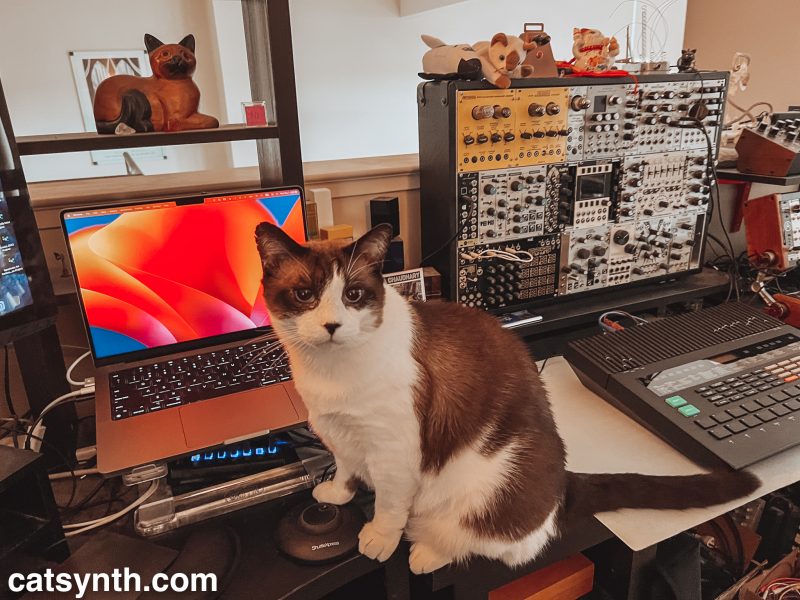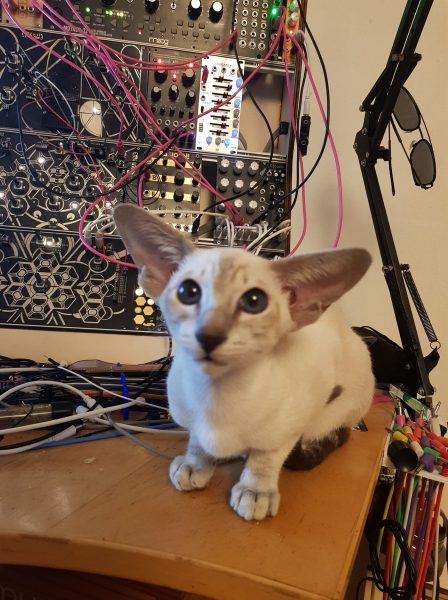The 2012 Outsound Music Summit began this Sunday with the annual Touch the Gear Expo. Visitors have a chance to see and try out the equipment used by musicians and sound artists. Although we had fewer presenters this year, we had a variety of instruments and devices, and a fairly sizable crowd of visitors.

In the above image, we see Matt Davignon presenting effects pedals driven using a Casio keyboard, and Joe Lasquo presenting laptop-based programs with Max/MSP.
One of the fun aspects of Touch the Gear is getting one’s hands on instruments that one only sees on stage. For me, one of those opportunities came when I got to play the Arp 2600 that Benjamin Ethan Tinker brought to the event. It was only a little over a week earlier that I heard him play it at the Luggage Store Gallery.

But it there is the discovery of new and never-before seen musical creations. The most unusual for me was this creation by Omer Gal:

The organic head-like element contained several mechanical and optical sensors that one could touch or put ones hands near to affect the sound. A second part of the installation included a mechanical “robot” that played a set of strings with a pickup. The performer can affect the operation of the robot and the sound through electronic controls.

Other unusual electro-acoustic instruments were presented by Walter Funk and Dan Ake. Walter Funk’s metallic instrument called Ulysses offered opportunities to explore different resonances and timbres through sheets of metal, rods and springs arrayed throughout its body. Dan Ake’s invention was a series of gridded metal inside a large wooden box, than one could excite with a variety of objects, such as bows, rods and a glove with long wooden fingertips.

I was presenting at this event as well. I always try to bring something a little different each year. This year, I decided to go with two ends of the technology spectrum: an iPad running Animoog and iMS-20, and a Eurorack modular system with a Metasonx R53, Make Noise Echophon, Malekko Heavy Industry Anti-Oscillator, and several others. Both technologies caught people’s attention, with some more excited about the analog modular system with its physical knobs and cables, and others gravitating towards the iPad.

Andrew Wayne presented a very tangible set of objects containing unpopped popcorn kernels in aluminum trays and other contains, augmented with contact microphones and electronic effects. He assembled his own contact mics to use with these acoustic sources.

Other participants included CJ Borosque with an Alesis Air, Laurie Amat with vocal and ambient sources into a Line 6, and a surface by April-Jeanie Tang with rubber-ball mallets. Through contact miss, the action of the rubber mallets and the surface and transmitted to effects processors for a deep, haunting sound. Tom Duff presented a series of software processes that could be randomly controlled from a MIDI controller. Despite the randomness, it was quite expressive after playing with it and dialing in on particular processes. He also had a couple of critters from Bleep Labs.

Long-time participants Tom Nunn and David Michalak were back again with the most recent incarnations of the sketch box. You can read an interview with Tun Nunn and discussion of his musical inventions here on CatSynth.

And finally, Bob Marsh was back with his intriguing and “charismatic” metal creations.

I do tend to gravitate towards metallic sounds when looking for new material, something which seems to be common among those who are looking for invention and discovery in musical sound.
On Monday night, the summit continued with the Composers Symposium, a panel discussion featuring four of the composers in this year’s festival: John Shiurba, Christina Stanley, Benjamin Ethan Tinker, and Matthew Goodheart were on hand to discuss their work. And as a first this year, I acted as the moderator for the evening. It was a great experience, and I did not have to do very much besides seeding the discussion with a few questions. From those starting points, a lively discussion ensued among the composers as well as dialog with the audience. We talked about the role of notation in each of the composers’ music, such as Stanley’s use of paintings as her scores and Shiurba’s use of graphical elements derived from print newspapers (a major theme of his piece this year); and the dual role that these artists played as both composers and performers. One of the things that made this panel work was the variety of musical disciplines, styles and backgrounds among the participants, as well as the interest that the audience brought to the discussion with their numerous questions. Everyone had criticisms of the terms “new music” and “experimental music” that are often used as blanket designations for the music featured in the summit and indeed much of the music reviewed here on CatSynth, but that was to be expected. The two hours of the discussion went by rather quickly, and I’d like to think everyone on the panel and in the audience found the experience enjoyable and illuminating. I would definitely like to do more of these at events in the future.














